




Introduction to the Human Brain
The brain is the largest and most complex organ in the body. It has more than 100 billion neurons or brain cells that form numerous synapses in the body for communication. It acts as a controlling centre and manages our thoughts, emotions, movement, vision, breathing, touch, temperature, hunger, and every vital function. The brain and the spinal cord make the CNS or central nervous system.
Any damage to the brain or spinal cord due to a sudden jerk, accident, trauma, or disease may hamper their functioning and can lead to death in severe cases. Therefore, we have the skull outside the brain, which acts as a shock absorber and protects it from damage.
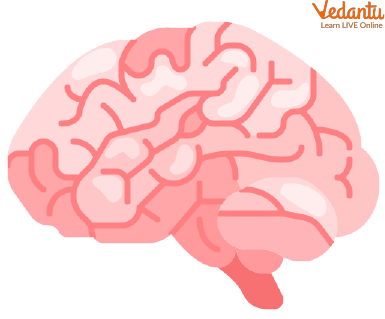
Human Brain
What is the Human Brain Composed of?
The human brain weighs around 3 pounds (1.4 kilograms) in an average adult. It is composed of organic matter. Two-thirds of the brain is made of fat, and the remaining is a combination of proteins, water, salts, and carbohydrates. It contains nerves and blood vessels.
How does the Brain Work?
The human brain collects and sends electrical and chemical signals throughout the body. Each signal determines a different process, and our brain interprets it. Some make us feel tired, while others may cause pain.
However, the interesting fact is that it keeps some messages within itself, and others are spread throughout the body through nerves. These messages are conveyed by neurons or nerve cells. These are responsible for collecting sensory input from the outer environment and sending commands to muscles to perform functions.
What are the Main Parts of the Brain and their Functions?
The human brain has three main parts; cerebrum, brainstem, and cerebellum. Let us understand these using the brain parts diagram given below.
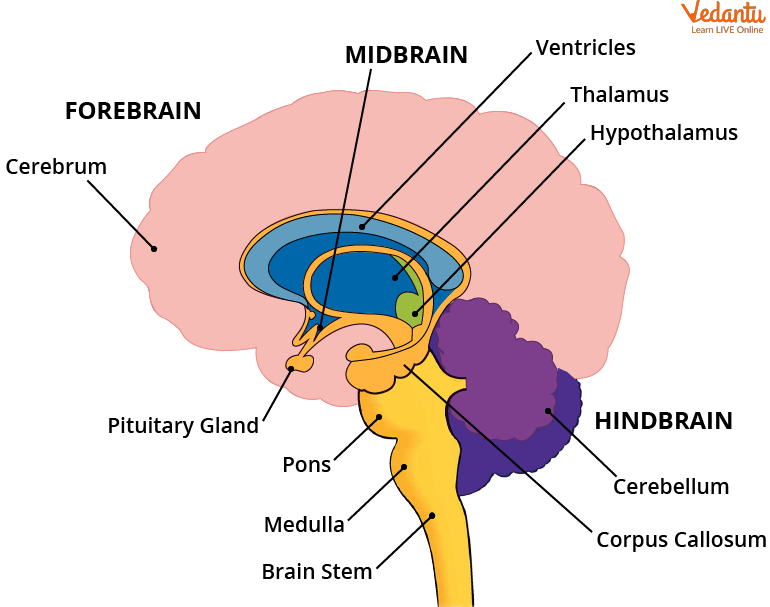
Human Brain Parts
Cerebrum
The cerebrum is the frontal and the largest part of the brain. It regulates temperature and initiates and coordinates movements. Other parts of the cerebrum control speech, problem-solving, reasoning and thinking abilities, judgement, vision, hearing, touch and learning, and emotions.
Refer to the cerebrum diagram for better understanding.
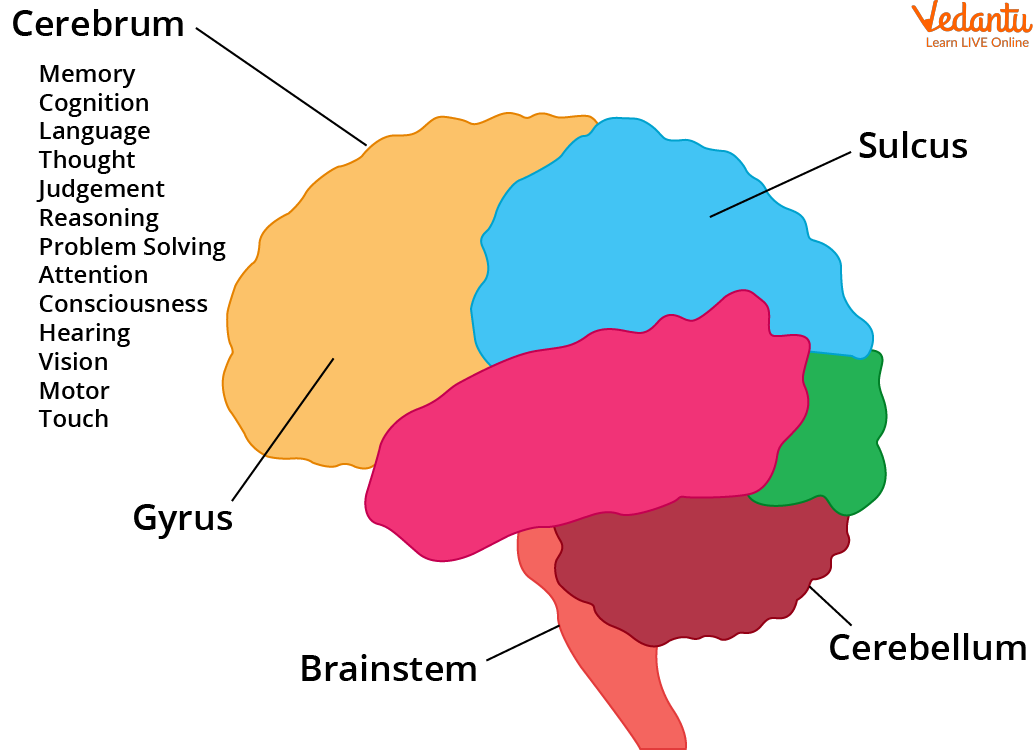
Cerebrum
Brainstem
The brainstem is the middle part of the brain that connects the cerebrum and the spinal cord. The brainstem is classified into the midbrain, the pons, and the medulla as shown in the brainstem diagram.
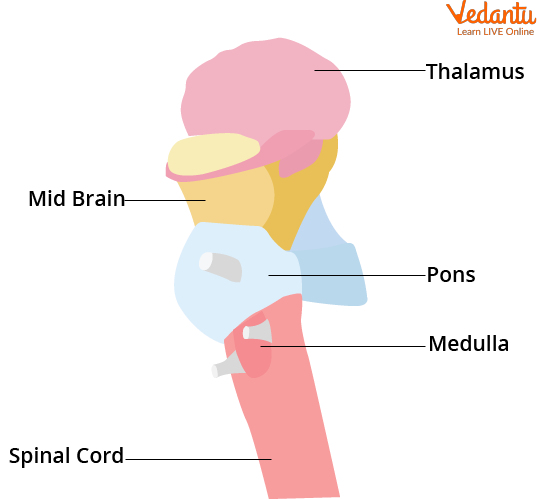
Brainstem
1. Midbrain: The midbrain is a complex structure and has different types of neurons, layers, and other structures. It facilitates functions from movement and hearing to analysing environmental changes and responses.
2. Pons: It is the second-lowest structure of the brainstem and lies above the medulla. It contains nerves that are connected directly to the brain. These nerves are important and help in controlling the senses and various parts of the mouth and face. The pons enables different functions, such as sleep, tear production, blinking, chewing, focusing vision, hearing, pain management and feeling, control and coordination, and facial expressions.
3. Medulla: It is at the bottom of the brainstem. It is the meeting point for the brain and the spinal cord. Functions of the medulla include; managing and controlling heart rate, breathing, blood pressure, carbon dioxide, and oxygen levels. It produces reflexive actions or involuntary movements that occur after exposure to a stimulus. These can include sneezing, coughing, swallowing, and vomiting.
Cerebellum
It is a structure situated at the back of the brain. It is divided into two hemispheres that control muscular activities, such as walking, balance, posture, speech and learning motor behaviours.
The Spinal Cord
The spinal cord runs at the back of the body from the bottom of the medulla through a large opening at the bottom of the skull. It is supported by the vertebral bones, which prevent it from external jerks or damages. It helps in receiving and sending signals to and from the brain to other body parts. It enables reflex actions, balance and coordination, mobility, and sensory functions.
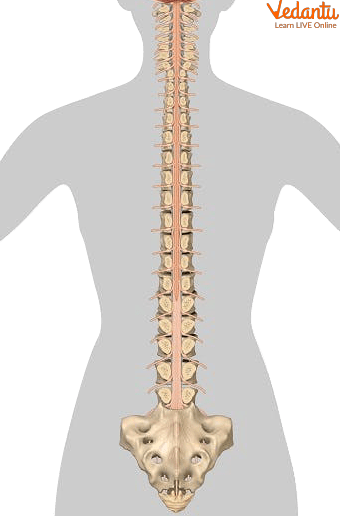
Spinal Cord
Sample Questions
State whether the statements mentioned below are correctly stated or not:
1.The cerebrum is divided into two hemispheres by a deep groove.
Ans: True.
2.The cerebellum is the main part of the forebrain.
Ans: False, the cerebrum is the main part of the forebrain.
3.The brain is protected inside the skull.
Ans: True
4.The brainstem connects the brain to the spinal cord.
Ans: True
Learn by Doing
Complete the the statements that follow by filling in the blanks:
1.The forebrain is classified into ________ lobes.
Ans: four
2.The brain is covered by a ______ layered meninges.
Ans: three
Segregate the given parts of the brain into the given categories:
Forebrain
Midbrain
Hindbrain
Cerebrum
Cerebellum
Thalamus
Pons
Medulla
Hypothalamus
Lobes for vision
Lobes for hearing
Ans: Forebrain: cerebrum, thalamus, hypothalamus
Midbrain: lobes for vision, lobes for hearing
Hindbrain: cerebellum, pons, medulla.
Summary
The brain is the vital organ of the human body. It is like an intelligent machine that controls different functions ranging from managing movements to sensory activities. It consists of billions of neural cells that help in receiving and processing information.
FAQs on Human Brain
1. Which is the front part of the brain, and what are its functions?
The front and the largest part of the brain is called the cerebrum. It is divided into two parts, and each part is located on each side of the brain. This part is responsible for the following major processes:
Learning
Problem-solving
Thinking
Emotion
Controlling and activating movement
Besides the above-mentioned processes, the cerebrum plays a major role in brain functioning. It regulates body temperature and enables humans to speak and judge things. Its other functions are related to touch, hearing, vision and other senses.
2. How to keep the human brain healthy?
The following practices will keep the human brain healthy and improve brain functioning:
Keep the brain hydrated by drinking lots of water.
Perform mental workouts such as reading books and solving puzzles to keep the brain strong and fit.
Do physical exercises to improve the ability to understand and reduce stress.
Consume healthy food as the brain needs lots of minerals and vitamins to function properly.
Always wear helmets while riding scooters, bikes or bicycles to keep the head safe.
Getting proper sleep as sleep will give the brain a chance to rest.
3. What is the importance of the spinal cord?
The spinal cord is a lengthy band of tissue that resembles a tube. It ties your brain and lowers back together. Your spinal cord relays nerve messages back and forth from your brain to your body. You can experience feelings and move your body thanks to these nerve transmissions.









